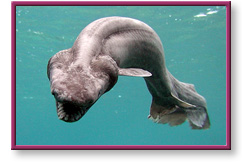On January 21, 2007, a species of shark sometimes referred to as a living fossil was spotted south of Tokyo in the coastal waters of Numazu in Shizuoka, Japan.
MSNBC.com's Dara Brown reported that a fisherman at a nearby port first spotted this odd-looking eel-like creature and immediately notified the Awashima Marine Park. The 5' 3" long (160-centimeter) gray creature was caught and transferred to a seawater pool in the marine park where it was quickly identified as a female frilled shark, named for its six protruding gill slits. Because its natural habitat is 2,000 feet (609 meters) or more under the sea, this kind of shark is rarely seen alive.
Sadly, the living fossil died hours after it was caught. "We think it may have come to the surface because it was sick, or else it was weakened because it was in shallow waters," a park official said. Fortunately, park staff members were able to film the creature for a short time as it opened its jaws and swam in the seawater pool.
Frilled sharks, which can grow up to 6' 6"
(2 meters) in length, often feed on other sharks and sea creatures. Occasionally, they are accidentally caught in the nets of trawlers in Japanese waters and are sometimes found in fertilizer, animal food, and even on dinner plates.
National Geographic reported that this serpentine specimen is a cousin of the great white, the hammerhead, and other sharks. While it looks like a large brown or gray eel, its six slit-like gills help mark it as a shark. With a mouthful of small, sharp tricuspid (three-pointed) teeth, the frilled shark may be a fearsome hunter, but it is considered harmless to humans. Those needle-like choppers are better suited to squid and other sharks found in the deep sea. The World Conservation Union (IUCN) lists the species as near threatened, meaning that it is "close to qualifying for
or is likely to qualify for a threatened category in the near future."
The amazing frilled shark is known as a "living fossil" because — according to evolutionary theory — it was supposed to be extinct years ago. Yet, the frilled shark has refused to "evolve" over time, keeping its slinky shape and upper jaw which has been a part of its skull since early times. Most living sharks have hinged top jaws, so this "ancestor" of modern sharks is yet another incongruency in the faulty hypothesis of evolution.


